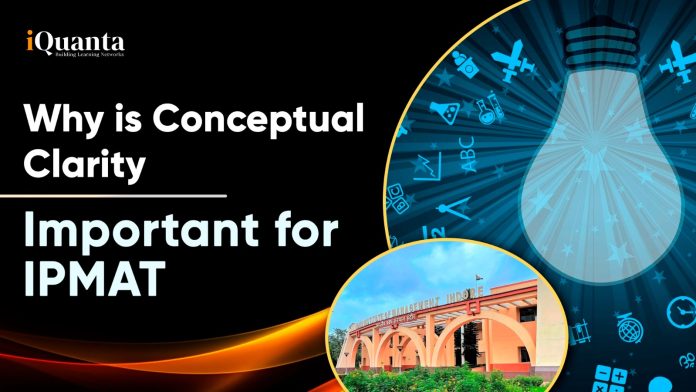Every year, thousands of students set their sights on the IPMAT (Integrated Programme in Management Aptitude Test), aiming for a seat at some of India’s most prestigious institutions like IIM Indore and IIM Rohtak. While motivation, consistency, and mock test performance are all key parts of the preparation puzzle, one of the key factors that quietly determines who crosses the finish line is conceptual clarity.

IPMAT isn’t a test that rewards surface-level preparation. Its structure and question patterns are carefully designed to assess how deeply you understand core ideas. In this blog, we’ll explore why conceptual clarity is non-negotiable, how it influences every aspect of your IPMAT prep, and how some prep methods can help you make that difference.
Role of Conceptual Clarity in IPMAT
Conceptual clarity is the ability to not just recognize a topic or formula but to fully grasp why it works, how it’s used, and when to apply it. It’s the difference between learning a trick and learning the logic. In IPMAT, many questions combine elements from different topics, this clarity becomes the most valuable tool.
| Issue | Consequence |
| Memorizing formulas without understanding | Confusion when the question is framed differently |
| Practicing without reviewing mistakes | Repeating the same errors, leading to stagnation |
| Over-focusing on mocks | Ignoring the learning phase, which results in missed conceptual understanding |
The Quantitative Aptitude Section is a clear example. A single problem may require a blend of ratios, averages, and time-speed-distance logic. Without a solid understanding of each, you’ll either misinterpret the question or take a long, inefficient route to the answer. The Verbal Ability section is no different. Questions that test tone, context, or grammar don’t just need vocabulary; they require a nuanced grasp of structure, intent, and rule-based reasoning. Guesswork rarely works, especially when answer choices are designed to confuse.
Importance of Conceptual Clarity in IPMAT
There’s a common trap many aspirants fall into: assuming that solving dozens of questions from a chapter equals mastery. However, that approach can be deceptive. You might breeze through well-practiced problems yet struggle when a question is framed differently, even though it’s testing the same concept. This gap happens when you learn solutions rather than ideas.
Take a topic like Time and Work. You might be able to plug numbers into a formula and get the answer during practice. But what happens when the question involves multiple workers, alternating shifts, and variable efficiency? Without clarity, you’ll struggle with questions that require application or novel approaches, even if you’ve already memorized the steps.
Many students assume that clarity slows them down and that spending extra time understanding a concept in depth means covering fewer topics. Ironically, the opposite is true. Once your understanding is solid, problem-solving becomes much faster because you can instantly recognize what the question is about and which approach to use. This speed also translates into better time management in the actual exam. You’re not hesitating, second-guessing, or stuck trying to remember which shortcut applies. Instead, you’re moving with purpose, armed with both understanding and intuition. Moreover, clarity empowers strategy. It helps you decide which questions to attempt, which to skip, and how to make educated guesses when needed.
The Two-Part Prep Approach: Learning + Application
One of the most effective ways to build conceptual clarity is to treat preparation as a two-stage process. First, there’s the learning stage, where concepts are introduced, explained, and understood deeply. Then comes the application stage, where those concepts are tested across various problem types, levels of difficulty, and contexts.
This approach, though seemingly obvious, is often missing from standard preparation routines. Some students get stuck in theory, watching videos or reading PDFs without testing themselves enough. Others focus entirely on mocks and drills, skipping the clarity phase and hoping that practice will somehow build understanding. But the reality is, both stages are essential — and they need to work together.
Several modern learning platforms, including iQuanta, have adopted this dual pedagogy model, combining live concept-building sessions with application-driven problem-solving classes. This balanced approach ensures that students not only understand the theory behind every topic but can also apply it effectively in an exam scenario. It’s the best way to ensure conceptual clarity translates into real-time exam success.
There are no overnight hacks to crack IPMAT. But if there’s one thing that consistently sets top performers apart, it’s their clarity of thought. They’ve trained themselves not just to know the syllabus but to understand it inside out and that understanding powers everything they do, from question selection to time management and decision-making under stress. If you’re targeting IPMAT 2026 or 2027, starting early with a reliable platform like iQuanta can provide the strategic edge needed to excel in this competitive exam.


